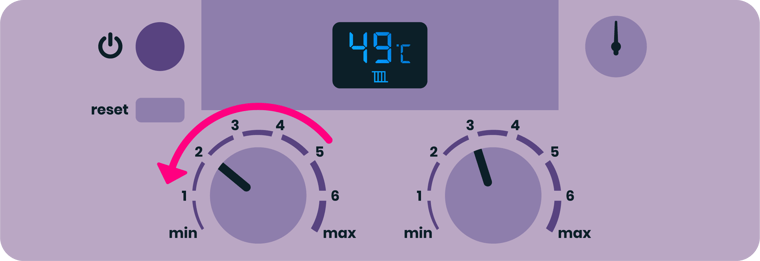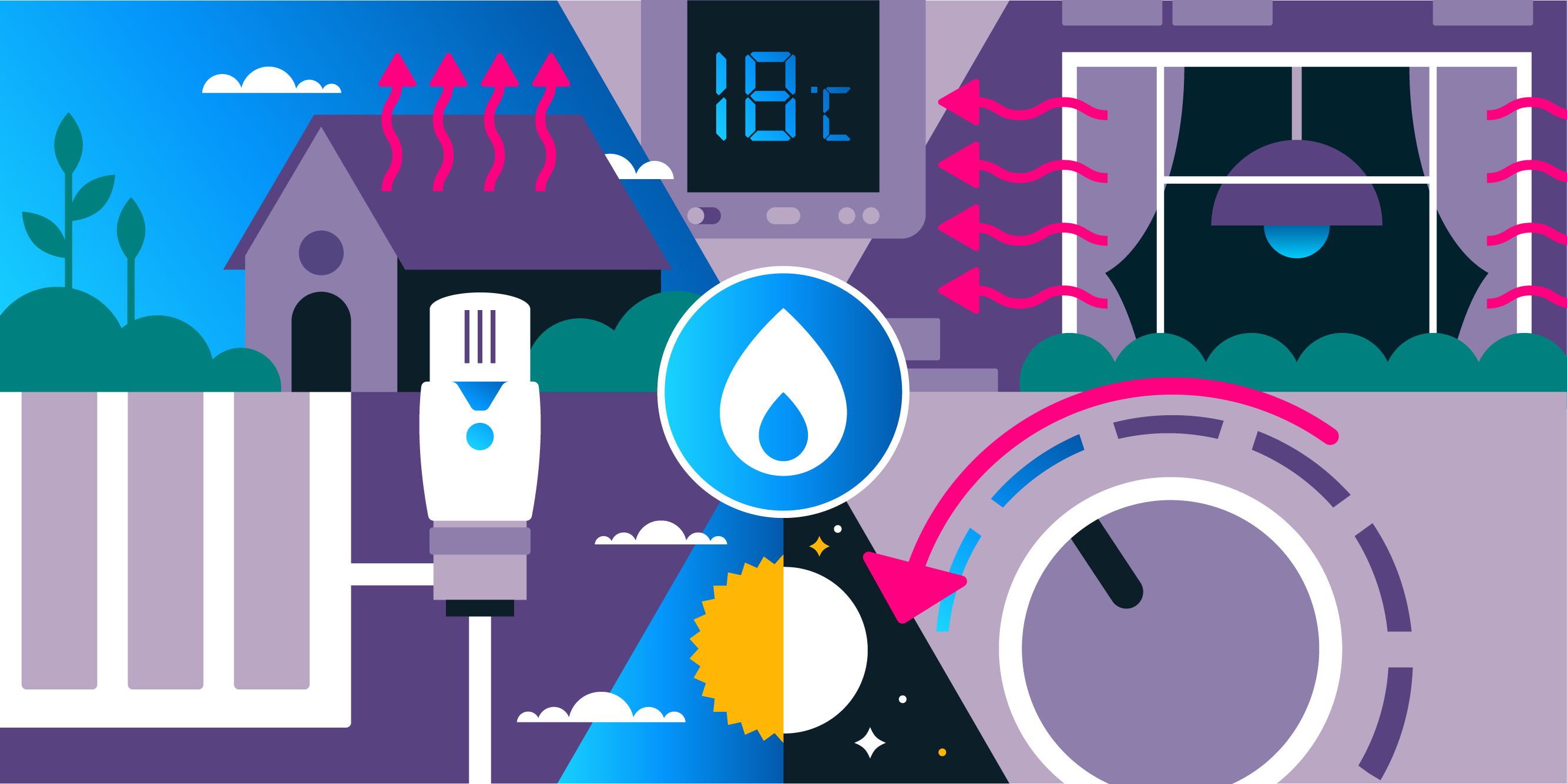6 ways to reduce your gas usage this winter
An average UK home uses 80% of its gas for heating. That's £1,000 a year at Winter 2022's prices. The other 20% of gas is used on hot water and cooking.
Whether you use more or less than average, you can save money by understanding how you use gas. In this blog we go through the best ways to save.
Wasted energy makes up 30% of the average energy bill - do something about it! Get more from your smart meter with Loop.
But saving money isn't the be all and end all. Being warm is important for your health and wellbeing. After making any changes, make sure you and everyone else living with you remain comfortably warm.
1. Get your heating schedule right

Using your heating controls to set the best schedule for you can lead to big savings.
Schedule your heating to only be on when you're normally in, then add an hour if you're at home unexpectedly. When setting your schedule, have the heating turn off up to twenty minutes before you leave the house. With hot water in the radiators you'll stay warm without needing to burn any more gas.
If you're going away, either turn the boiler off or reduce the thermostat to a low temperature. We’d recommend 5 degrees to use minimal gas whilst stopping any pipes freezing during a cold snap.
Overnight, having your heating off or at a low temperature uses less gas than running the heating on full. It’s important you feel warm. But achieve this with the right bedding or an electric blanket. On very cold nights, it can be worth putting the heating on. But make sure the thermostat is at a lower temperature than during the day.
2. Get the right temperatures for you

If it’s 10 degrees outside and your thermostat is set to 20, then your heating has to do 10 degrees of heating. If your thermostat is set to 18, then your heating only has to do 8 degrees of heating.
It may sound small, but that’s 20% less heating and 20% less gas.
With each degree you lower your thermostat, your gas use falls by 10%. Dropping from 21 degrees to 18 would save around 30%. That's £300 for an average home.
So, how to do it? The key is to stay comfortable whilst reducing the temperature.
-
Wear extra layers, thicker clothes and get your slippers out.
-
Close the curtains and internal doors to stop draughts. Draughts make you feel colder and a natural reaction is to put the thermostat up. Stop the draughts instead!
- Get the high tog duvet out and add extra bedding. Consider using hot water bottles or an electric blanket to keep warm overnight. This stops you heating the whole house.
When we talk to Loop customers we find a wide range of thermostat settings. There's no right or wrong. The most important thing is that everyone in the home feels comfortable. If you can stay warm and save money it's a win-win.
3. Draught-proof

Draughts allow warm air to leave your house, wasting gas. The feeling of a cold draught will make you feel colder and less comfortable too. So draughts are double trouble.
How to get rid of them? The most common areas are around windows, doors, and unused chimneys. Luckily there are cheap ways to stop these draughts. Use draught proofing tape to seal round doors and windows. Use chimney balloons to block unused chimneys. The Energy Savings Trust estimates these changes save a typical semi £90 a year. They have some great advice on how to draught-proof here.
As well as stopping external draughts, reduce internal draughts by keeping internal doors closed to feel warmer.
Be careful as you draught-proof. Your house needs ventilation. Ensure you only draught-proof areas where there shouldn’t be draughts such as around windows and doors. Keep air bricks clear, open trickle vents on windows and ensure bathrooms and kitchens are well ventilated.
4. If you have TRVs, use them!

TRVs are rotating dials on radiators. Have them? Use them!
A TRV gives control over the temperature of a room when your heating is on. It will stop hot water flowing into a radiator when the room temperature reaches a certain level. This avoids wasting money by over-heating rooms. If the temperature in the room falls below your set temperature, the TRV will open and hot water will flow into the radiator. If you set the TRV to a low value it will keep the room cooler (saving you gas). If you set it to a high value the room will get hotter.
TRVs are easily misunderstood! Some people set them to the maximum thinking this will lead to the room heating up quicker. This isn't the case. TRVs control when to stop heating in a room and don't affect the time it takes to get to temperature.
We recommend lower temperatures in bedrooms than living areas, and even lower temperatures in unused spare rooms. It may take a bit of trial and error to get your settings right, but it can lead to high savings.
5. Turn down your flow temperature

Did you know that your boiler settings affect how efficiently you heat your home?
The temperature of the water that leaves your boiler to go to your radiators is called the boiler's flow temperature. This flow temperature can vary significantly from house to house.
Crucially, if the flow temperature is set too high then the boiler will run inefficiently. Correcting this can save 8-12% on your gas bills.
Follow Nesta's advice to check and fix your boiler's settings here.
6. Insulation

UK homes are poorly insulated compared to other countries in northern Europe.
The two insulation measures that pay themselves back quickest are loft insulation and cavity wall insulation. Many homes have had these measures done but there are still millions of homes without.
Check your loft to see if you have at least the recommended 27cm of insulation. If not, you can top up yourself or pay a professional to do it for you.
The Energy Saving Trust have a great page explaining cavity wall insulation here. It answers the key questions: Do I have a cavity? Does it need insulating? What would it cost and how much would I save?
If your walls don’t have a cavity you’re not alone. There are over 7 million homes in the UK without a cavity. These are called solid wall homes and were typically built before the 1930s. Solid walls are poorly insulated meaning the cost savings from insulation are high. But adding insulation is both difficult and expensive. Your options are to add insulation to the inside (internal wall insulation) or outside of the walls (external wall insulation). Internal wall insulation is disruptive and best done during a renovation project. External wall insulation is less disruptive. It can also improve the appearance of the house. Find out more from the Energy Saving Trust here.
• • •
Cut your energy bill with Loop
Loop is a FREE energy-saving app that links to your smart meter, analyses your energy use and shows you easy ways to save. On average, Loop users cut their electricity use by 16% and their gas use by 10%! How much could you save?








